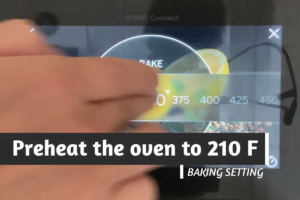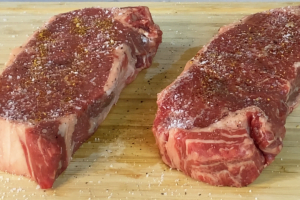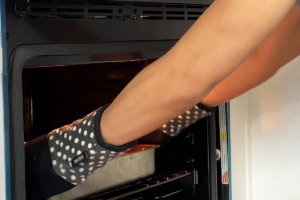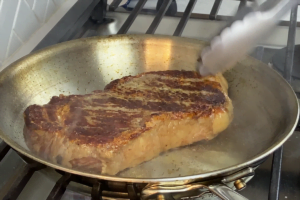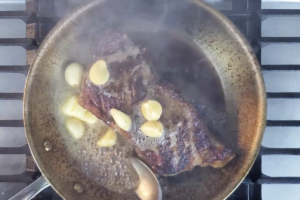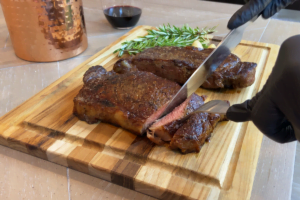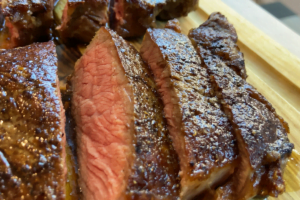Perfect Reverse Seared Steaks with Stainless & Cast Iron
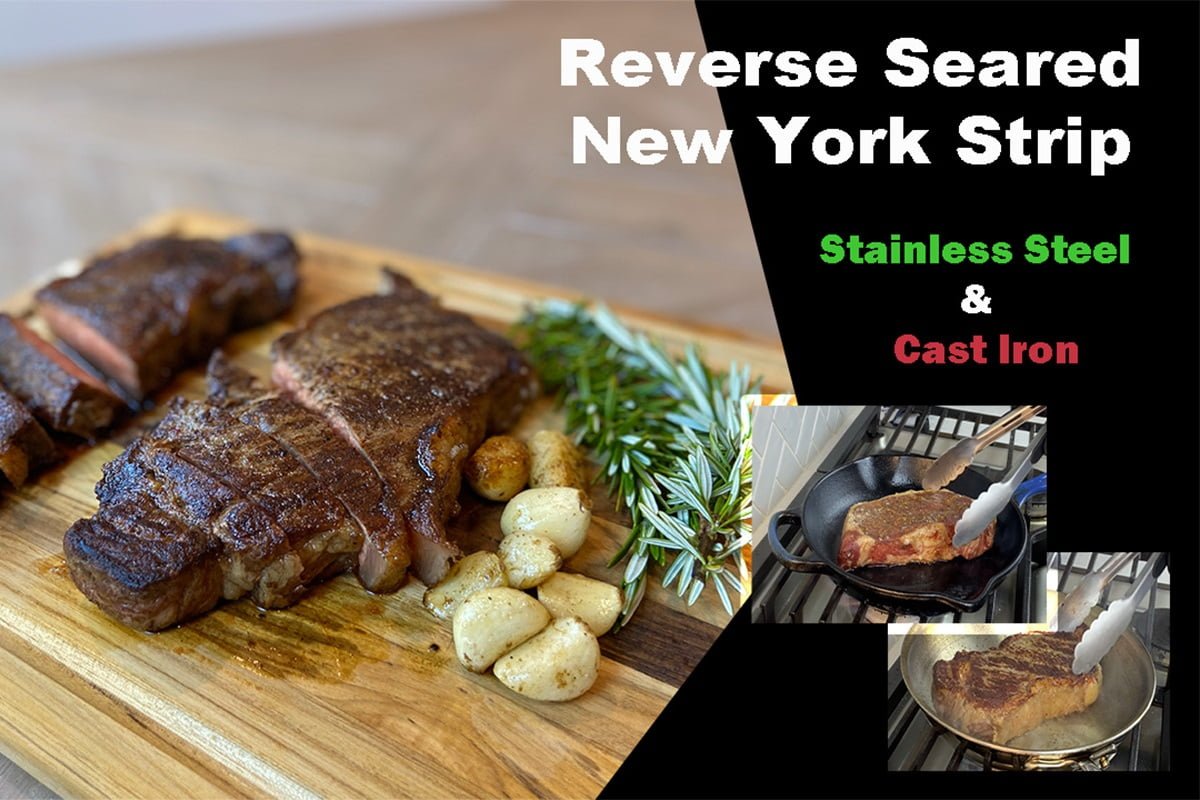
Reverse seared steak is a standout method for cooking, ensuring a perfectly cooked steak every time. In addition to the delicious taste, reverse searing offers practical benefits beyond the kitchen. This method simplifies cooking by minimizing smoke, cutting down on oven cleaning time, and preventing pesky smoke alarms from interrupting your meal prep.
What is reverse searing?
It’s a cooking method in two steps that flips the usual way of searing steak. Instead of searing first and then finishing in the oven, you bake the steak at low heat and then quickly sear it at high heat. This results in a steak that’s evenly cooked and juicy, with a crispy outer layer—a perfect steak for anyone who loves steak. Plus, it cuts down on smoke while cooking, which is a bonus for home cooks.
The New York Strip: An Excellent Candidate
The New York Strip is a top pick for reverse sear steak, but the right steak ultimately depends on your preferences and the qualities of different cuts. Thicker steaks work best for this method, and a high-quality, thick New York Strip is a great match.
This type of steak, also called a strip steak, comes from the cow’s short loin. Steak lovers adore it for its rich marbling, strong flavor, and perfect mix of tenderness. These qualities make it ideal for reverse seared steak. It has a good amount of lean meat and a flavorful layer of fat that melts down beautifully.
When you slow-cook a well-marbled New York Strip at low temperatures, the fats gradually melt, giving the meat a richness that adds to its tenderness. A quick high-heat sear at the end creates a deliciously crispy outer layer, balancing perfectly with the tender inside.
While the New York Strip is a top choice for reverse sear steak, other cuts like ribeye, T-bone, and filet mignon can also work well with reverse searing, thanks to their thickness and marbling. Each cut brings its own unique flavor and texture to the table.
Cast Iron vs. Stainless Steel
When it comes to cooking reverse seared steaks, both stainless steel and cast iron pans get the job done well, but they each have their own characteristics that affect how you cook and the final result.
Cast Iron Skillets
PROS
Cast iron skillets are famous for holding onto heat really well and spreading it evenly when cooking reverse sear steaks. Once they’re heated up, they stay hot, which helps create that perfect caramelized crust on your steak, making for an excellent sear. This crust not only gives your steak a great texture but also boosts its flavor, thanks to a chemical reaction called the Maillard reaction, which occurs when amino acids and sugars react to heat. You can use cast iron pans on the stove and in the oven, which is handy for the reverse searing method that requires both types of cooking.
CONS
On the downside, cast iron pans take a bit longer to heat up and need regular seasoning to stay nonstick. They’re also heavier, which might make them trickier to handle when cooking reverse sear steaks.
Stainless Steel Cookware
PROS
In contrast, stainless steel pans are lighter and easier to manage when cooking reverse sear steaks. Plus, they handle acidic foods better than cast iron, which can sometimes react with acidic ingredients and give your food a metallic taste.
CONS
Stainless steel pans heat up faster than cast iron, but they don’t hold onto heat as well when cooking reverse sear steaks. This can lead to uneven cooking if you’re not careful. While stainless steel pans are good for getting a nice sear, they generally don’t give you the same level of browning as cast iron pans because they don’t hold onto heat as much.
In conclusion, both types of pans have their good points and drawbacks. When you’re cooking your reverse seared New York Strip steak, your personal preferences, the tools you have, and what cooking qualities matter most to you might all help you decide whether to go with stainless steel or cast iron.
Perfect Reverse Seared Steaks with Stainless & Cast Iron
Equipment
- 1 stainless steel skillet
- 1 cast iron skillet
Ingredients
- 2 New York Strip Steaks (approximately 1.5 inches thick)
- 2 tablespoons of Avocado Oil
- 2 teaspoons of Espelette Pepper (optional)
- 1/3 cup of Butter
- 10 cloves of Garlic
- Salt and Pepper (to taste)
Instructions
- First, preheat your oven to 210°F.
- Remove the two steaks from the refrigerator 30 minutes before cooking, allowing them to reach room temperature. This will ensure a more consistent cook.
- Pat the steaks dry with a paper towel. Then, lightly brush them with avocado oil. Season each side with salt, pepper, and Espelette pepper to add a touch of spice.
- Put the seasoned steaks in the preheated oven and cook for 45 minutes and take the steaks out after that.
- Next, heat avocado oil in a stainless steel skillet or a cast iron skillet over high heat. When the oil shimmers or ripples, it's ready. Carefully add the first steak to the skillet and sear each side for about 2 minutes to develop a rich brown crust.
- Reduce the heat to medium and add butter and garlic to the skillet. As the butter melts, continuously baste the steaks with it for about 1-2 minutes.
- To achieve a medium-rare steak, cook for a total of 7-10 minutes, or until it reaches an internal temperature of 132°F. For medium, aim for 140°F. Remember that the cooking time might vary depending on the thickness of your steak.
- Once the steak is cooked to your liking, take it out of the skillet and let it rest for about 5 minutes before cutting into it. This rest time allows the juices to redistribute throughout the steak.
- Finally, serve the steaks topped with the remaining garlic butter from the skillet and your choice of sides. The generous amount of butter and garlic in this recipe gives the steak a buttery and garlicky flavor.
Video
Notes
- Quality of the Steak: The quality of the steak is crucial. Opt for a high-quality, preferably dry-aged, New York Strip steak. It should have a good amount of marbling (the little white flecks of fat within the meat), which will melt during cooking and add flavor.
- Temperature Monitoring: Use a good quality instant-read thermometer or a probe thermometer. Don’t guess the doneness of your steak by time alone – always check the temperature to ensure you cook it to your liking.
- Seasoning: Don’t skimp on the salt. Season generously with kosher salt, as this will not only enhance the flavor but also aid in forming a nice crust when searing.
- Resting the Steak: Rest your steak both before and after searing. Resting before searing helps to bring the steak to room temperature for even cooking. Resting after searing allows the juices to redistribute throughout the steak, preventing them from running out onto your plate when you cut into it.
- Preheating the Skillet: Make sure your cast iron skillet is very hot before you add the steak. This ensures a nice, flavorful crust forms quickly, without overcooking the inside of the steak.
- Basting: While the steak is searing, baste it with the butter and oil mixture. This not only adds flavor but also helps to cook the steak evenly by enveloping it in a layer of hot fat.


